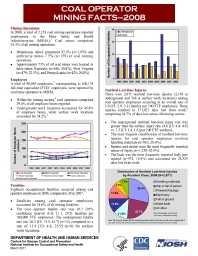Mining Publication: Coal Operator Mining Facts - 2008
Original creation date: March 2011
Mining Operations: In 2008, a total of 2,129 coal mining operations reported employment to the Mine Safety and Health Administration (MSHA). Coal mines comprised 14.3% of all mining operations. 1. Bituminous mines comprised 92.5% (n=1,970) and anthracite mines 7.5% (n=159) of coal mining operations. 2. Approximately 73% of all coal mines were located in three states: Kentucky (n=656; 30.8%), West Virginia (n=479; 22.5%), and Pennsylvania (n=425; 20.0%). Employees: A total of 90,055 employees, corresponding to 100,178 full-time equivalent (FTE), employees, were reported by coal mine operators to MSHA. 1. Within the mining sectors, coal operators comprised 29.4% of all employee hours reported. 2. Underground work locations accounted for 45.8% of employee hours, while surface work locations accounted for 54.2%. Fatalities: Eighteen occupational fatalities occurred among coal operator employees in 2008, compared to 28 in 2007. 1. Fatalities among coal operator employees accounted for 34.6% of all mining fatalities. 2. The coal operator fatality rate was 18.7 [95% confidence interval (CI): 11.1, 29.5] fatalities per 100,000 FTE employees. The underground fatality rate was 26.2 [CI: 13.5, 45.7] (n=12) compared to a rate of 11.9 [CI: 4.4, 25.9] (n=6) for surface work locations. Nonfatal Lost-time Injuries: There were 2,871 nonfatal lost-time injuries (2,103 at underground and 768 at surface work locations) among coal operator employees occurring at an overall rate of 3.0 [CI: 2.9, 3.1] injuries per 100 FTE employees. These injuries resulted in 171,021 days lost from work: comprising 44.7% of days lost across all mining sectors. 1. The underground nonfatal lost-time injury rate was greater than the surface injury rate (4.6 [CI: 4.4, 4.8] vs. I.5 [CI: 1.4, 1.6] per 100 FTE workers). 2. The most frequent classification of nonfatal lost-time injuries for coal operator employees involved handling materials (n=816; 28.4%). 3. Sprains and strains were the most frequently reported nature of injury (n= 1,230; 42.8%). 4. The back was the most frequently reported body part injured (n=472; 16.4%) and accounted for 28,329 days lost from work.
Authors: National Institute for Occupational Safety and Health
Brochure/flyer - March 2011
NIOSHTIC2 Number: 20039159
Pittsburgh, PA: U. S. Department of Health and Human Services, Public Health Service, Centers for Disease Control and Prevention, National Institute for Occupational Safety and Health, DHHS (NIOSH) Publication No. 2011-163, 2011 Mar; :1-2
See Also
- Coal Operator Mining Facts - 2005
- Metal Operator Mining Facts - 2002
- Metal Operator Mining Facts - 2004
- Metal Operator Mining Facts - 2005
- Noncoal Contractor Mining Facts - 2003
- Nonmetal Operator Mining Facts - 2002
- Nonmetal Operator Mining Facts - 2008
- Sand and Gravel Operator Mining Facts - 2006
- Stone Operator Mining Facts - 2003
- Stone Operator Mining Facts - 2005
- Page last reviewed: 9/21/2012
- Page last updated: 9/21/2012
- Content source: National Institute for Occupational Safety and Health, Mining Program


 ShareCompartir
ShareCompartir
